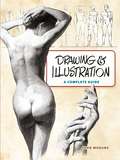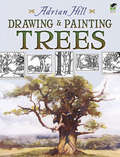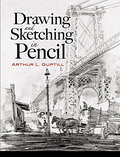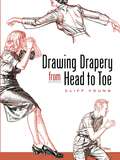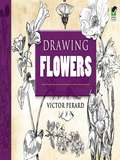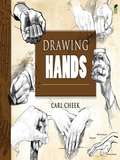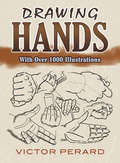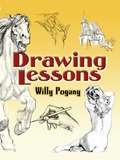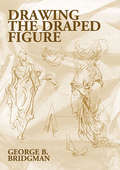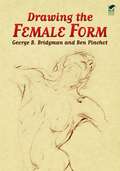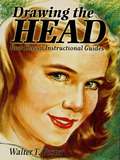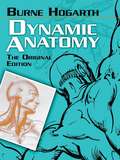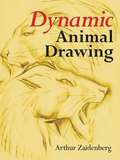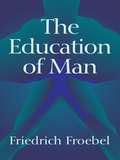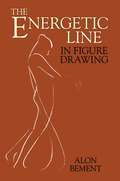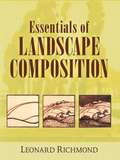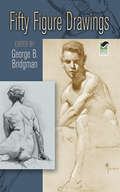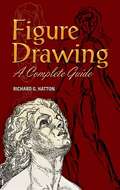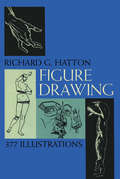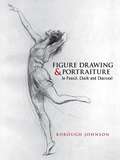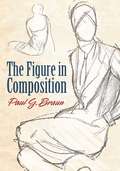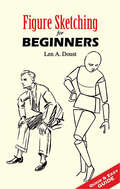- Table View
- List View
Drawing and Illustration: A Complete Guide
by John MoranzUtilizing as few words as possible, but presenting a tremendous variety and volume of illustrations, this all-in-one guide details the fundamentals of drawing in its various phases and fields. In the opening pages, the author points out the first step on the road to creative achievement: artists must learn how to see people and things in terms of pictures, then master the techniques needed to express themselves on paper.Geared to newcomers and yet still beneficial for more experienced artists, Moranz's illuminating advice covers everything from nude and draped figures to the art of portraits and sketching animals. He covers the effective use of various mediums, including pencil, charcoal, pen, and wash. Plus, he offers helpful tips on developing a sixth sense about perspective, the basics of composition, reflecting light and shadow, and more. There's even a chapter on taking drawing one step further -- from a pleasurable hobby to a successful commercial venture.
Drawing and Painting Trees (Dover Art Instruction Ser.)
by Adrian HillThis classic of art instruction by noted British painter Adrian Hill presents a well-rounded guide to portraying beeches, elms, pines, and many other varieties of trees. The three-part treatment begins with a brief but informative history of tree painting through the ages, highlighted with images by Titian, Rubens, Constable, Turner, and other masters. Advancing to a well-illustrated series of guiding principles, the author discusses the cultivation of an artistic appreciation for trees and offers preliminary drawing exercises. The third, and most extensive, section explores color choices and techniques. Progressing from simple to complex methods, Hill proposes the best materials for use in formats from monoprints and drypoint to mezzotint and etching. Additional topics include composition, style, patterns, and texture. Seven paintings in full color appear among the author's 150 helpful illustrations. A pioneer in the development of art therapy, Hill draws upon his vast experience in teaching students at every level to offer an accessible approach that will benefit all readers. A Foreword by Sir George Clausen introduces the text.
Drawing and Sketching in Pencil (Dover Art Instruction)
by Arthur L. GuptillThis classic guide offers clear, concise instruction in the basics as well as the finer points of pencil drawing. Appropriate for beginning and intermediate students, it features sixty-six well-chosen illustrations that encompass a wide range of subjects — mainly architectural, but also people, animals, and landscapes — and demonstrate a tremendous variety of techniques.An architect, painter, art director, and teacher, Arthur L. Guptill wrote several popular books on drawing. He begins this two-part treatment, aimed at architects, artists, and students, with discussions of drawing objects in outline and in light and shade, the principles of freehand perspective, methods of cast and life drawing, and sketching animals. The second part examines the choice of subjects and drawing in outline and in flat and graded tones. The important subject of composition receives considerable attention, with particular focus on unity and balance. Additional topics include working from photographs and from nature, the representation of buildings — including exteriors, interiors, and street scenes — and portraying details and accessories, from furniture, draperies, doors, and windows to clouds, water, and trees.
Drawing Animals
by Victor PerardA renowned artist/teacher expertly demonstrates the muted strokes, bold lines, and simple arcs needed to bring animal drawings to vivid life. Numerous sketches highlight these techniques for drawing more than 50 animals: bears, camels, deer, elk, lions, llamas, and others.Perfect for beginner or intermediate artists, this instruction book offers fascinating commentary that emphasizes animal anatomy and behavior. Its author and illustrator, Victor Perard, was a graduate of the École des Beaux-Arts in Paris and an art instructor at New York City's Cooper Union for twenty years. Perard's informative guide reflects his extensive teaching experience, providing practical advice for aspiring and experienced artists.
Drawing Boats and Ships
by Yngve Edward SoderbergAny artist who loves the beauty of nature and is drawn by the majesty of the sea will want to try sketching boats and nautical scenes. American painter Yngve Edward Soderberg, who spent much of his career mastering this art on the Mystic coast of Connecticut, was known for his breathtaking maritime art. In this concise guide, he makes it look easy with step-by-step instructions perfect for novices and anyone wanting to brush up on his drawing skills.From sailboats and dinghies to cruisers and whale ships, Soderberg shows how to observe and draw all that is seaworthy. Enhanced by expert commentary, over 100 illustrations include gulls, buoys, lighthouses, water surfaces, skies, clouds, and more. He even demonstrates how to sketch a boat's crew in action and offers valuable tips on perspective. Easy to follow, this essential guide helps hone all the valuable skills needed to create beautiful nautical compositions.
Drawing Drapery from Head to Toe
by Cliff YoungPacked with indispensable information on a vital aspect of drawing, this time-honored manual offers expert guidance on how to draw shirts, pants, skirts, gloves, hats, coats, and undergarments on the human figure. Step by simple step, artists will discover how these garments fit and drape the body at rest and in action. Abundant with detailed illustrations, photographs, and diagrams, Drawing Drapery from Head to Toe familiarizes readers with the properties of cloth and how it moves; it also examines the origins of folds in relation to the figure, the effects of pull and crush, action folds, creasing, and more. The result: a keen development of the essential techniques for creating realistic, masterfully rendered drawings of the clothed figure.One of few books on the subject of drawing drapery, this volume was written by a noted artist and instructor. Easy to follow, full of fascinating advice, and highly enjoyable to read, it is sure to become a well-thumbed guide.
Drawing Flowers
by Victor PerardA graduate of the École des Beaux-Arts in Paris, acclaimed artist and illustrator Victor Perard emigrated to the United States in the 1930s and taught at New York City's Cooper Union for twenty years. His popular series of art instructional books covers the essentials on drawing -- and his illuminating advice continues to help students and teachers today. In this illustrated guide to drawing Mother Nature's most beautiful flowers, Perard plants seeds of inspiration for artists of every ability. Dozens of black-and-white images highlight various techniques, as he shows how the variety of lines can add texture, light or movement to garden favorites. There are violets, daisies, and daffodils abloom, plus chrysanthemums, lilacs, lilies, and more. With a natural affinity for flowers of every kind, Perard reveals the rewards of this artistic effort -- developing a sense of composition and an eye for balance in design. Includes a list of state flowers.
Drawing Hands
by Carl CheekAn indispensable and easy-to-follow companion for the intermediate art student, this concise guide focuses on how to capture the natural representation of the human hand in all its forms and motions.Over 100 clear and expertly rendered drawings help artists discover:* The subtle but crucial differences between hands of young and old, male and female* How to accurately draw hands engaged in a variety of activities* Skeletal and muscular depictions, which help reveal how to naturally draw the workings of the magnificent human handEducated in England at the Chelsea School of Art and the Royal College of Art, the works of Carl Cheek were widely exhibited in Europe throughout the 1950s. His artwork is included in numerous private and public collections, including Britain's important and often-visited Government Art Collection.
Drawing Hands: With Over 1000 Illustrations (Dover Art Instruction)
by Victor PerardSecond in importance only to the face, hands play a key role in expressing emotional states—from anger and fear to resignation, serenity, and surprise. This resource features more than 1,000 illustrations, offering figure artists at all skill levels insights into the structure, character, and expression of hands. Artist and instructor Victor Perard emphasizes the anatomy of the hand: the bones that make up its framework and define its proportions and the muscles that direct its actions. In addition to notes on proportion and perspective, he groups the illustrations of hands in a manner that accents the modifications of their form as they are viewed from various angles. The tremendous variety of images ranges from male and female hands engaged in work and leisure activities to the hands of athletes, babies, and the elderly.
Drawing Lessons
by Willy PogányIn this essential guide to the basic principles of drawing the human figure, Pogany--one of the leaders of the Golden Age of Illustration--shows readers the path to artistic mastery. With a warm and supportive tone, he seamlessly blends instruction and insight with 375 masterful illustrations. The aim: to build a foundation for those who wish to draw skillfully and easily.Beginning with the humble dot and moving forward to perspective, anatomy, shading, portraiture, balance, motion, and more, this step-by-step resource is a genuine inspiration. Details of the human head, eyes, ears, and feet add depth to the instruction, followed by simple demonstrations that clearly illustrate how fundamental techniques are put into practice. Easy to follow and concise, this guide has long been considered an important resource for artists of all abilities.
Drawing the Draped Figure
by George B. BridgmanMany art students and professionals have mastered the art of depicting unclothed figures, but still have trouble accurately rendering clothing or other forms of draped cloth. Part of the problem — before this book came along — was that there was a lack of concise and simple instruction on the subject, and much that was written was too vague to be helpful. This comprehensive, well-illustrated book was created to solve the problem.In these pages George Bridgman — a longtime instructor at New York's Art Student League and one of the nation's foremost teachers of figure drawing — offers expert advice on depicting draped figures. "Clothing is none other than a drapery arranged around a body that is beneath it. To express the multitudinous forms it takes, one should learn to express in a direct way the different characters of folds, for each one plays its individual part as distinctly apart as actors play their different characters upon the stage."Students learn the characteristics of seven different kinds of folds and how to render them, including pipe, zigzag, spiral, half-lock, diaper pattern, drop, and inert folds. Mastery of these principles is the key to realistic portrayal of garments, as well as the proper rendering of cloth in still lifes. The straightforward, easy-to-follow text is illustrated by 200 of Bridgman's own sketches and diagrams, reproduced from pencil renderings in crisp halftones. Art students, teachers, and professionals alike are sure to welcome this inexpensive republication of a practical, hands-on manual by a master of figure drawing.
Drawing the Female Form
by George B. Bridgman Ben PinchotDesigned primarily for beginning artists, this excellent reference combines the precise results of the photographed figure with progressive drawings by a noted figure-drawing teacher whose works on anatomy have become classic references for art students.The well-illustrated manual provides painters, illustrators, and sculptors with invaluable instructions on rendering the intricacies of the female figure. George Bridgman's use of photographs and his drawings provide beginning artists with a suitable alternative to the use of costly live models for drawing exercises and studies in musculature and light.
Drawing the Head: Four Classic Instructional Guides
by Walter T. FosterAn accomplished artist and teacher, Walter T. Foster began producing his classic art instruction books in the 1920s. He wrote, illustrated, printed, bound, packaged, shipped, and distributed his books from his own home for decades, before moving the business to a commercial facility to accommodate his international trade. This comprehensive volume combines four of the artist's vintage instructional manuals to form an essential guide to illustrating the head and face. "Let your drawing be simple," Foster advises, and suggests that art students begin with the profile. Leave out unnecessary details until the basic shapes are in place. Then add the expressions that make the face the most interesting of all subjects. Instructions include step-by-step diagrams using charcoal, crayon, pencil, and brush to create finished portraits, plus tips on materials. With an array of subjects that include men, women, and children of various ages and ethnic types, this guide captures the mid-twentieth-century style of illustration to inspire today's artists.
Drawing Trees
by Victor PerardThis concise guide features easy-to-follow steps for capturing the natural beauty and magnificence of trees. Over 100 illustrations spotlight dozens of different varieties, including Oak, Willow, Pine, and Palmetto. Topics include shading techniques, composition, portraying shadow and light, and approaches to outlining.Author and illustrator Victor Perard, a graduate of the École des Beaux-Arts in Paris, was an art instructor at New York City's Cooper Union for twenty years. This informative volume reflects his extensive teaching experience and provides practical advice for artists at every level.
Dynamic Anatomy: The Original Edition
by Burne HogarthHailed by teachers, students, and critics for fifty years, this manual presents both action studies and practical diagrams for portraying the human figure in motion and at rest. Anatomical details appear in pragmatic, generalized shapes that simplify identification and reproduction. More than 300 images complement the easy-to-follow text, which includes a valuable survey of art history and magnificent figure drawings by such masters as Michelangelo, Rembrandt, Rodin, and Picasso.Burne Hogarth, called "the Michelangelo of the comic strip," is best known for his long-running Tarzan cartoons and for helping found New York's School of Visual Arts. In this study of the human figure, he explains muscular and skeletal structure from the artist's point of view, rather than that of the medical anatomist. Hogarth extends beyond the factual elements of anatomy to emphasize the relationship of mass to movement. His guide will prove an indispensable companion to artists at all skill levels who wish to render the human figure accurately and artistically.
Dynamic Animal Drawing
by Arthur ZaidenbergIn this step-by-step guide for beginning and intermediate artists, an expert teacher shows students how to see an animal in its simplest form and capture its essential character in a drawing. More than 500 illustrations demonstrate the depiction of familiar and exotic creatures--from dogs, cats, and birds to hippopotami, zebras, buffalo, and kangaroos. A noted painter, sculptor, and teacher, Arthur Zaidenberg based his techniques on the notion that anyone who can write the alphabet can combine simple shapes and draw. With his coaching, aspiring artists learn to look past the confusion of superficial details and discover an animal's distinguishing features. Preliminary and finished sketches accompany Zaidenberg's succinct, direct advice on recapturing the subtle strength of horses, the variety among canine breeds, the muscular grace of giraffes, the majesty of elephants, and other innate qualities of creatures from the animal kingdom.
The Education of Man
by Friedrich Froebel W. N. HailmannIn this classic of childhood education, Friedrich Froebel identifies the fundamental principles upon which he based his now-ubiquitous kindergarten system. Froebel demonstrates how to channel child's play and integrate it into the development of intelligence and social skills, explaining the vital inner connection between the pupil's mind and the subject of study.Impressed by the theories of Johann Heinrich Pestalozzi, Froebel developed an approach to early childhood education that exercised enormous influence over modern techniques, particularly those of John Dewey. Froebel espoused "self-activity" and play as essential factors in preschool education, maintaining that the teacher's role is not to drill or indoctrinate but to encourage self-expression through play. His method banishes mechanical and rote activities in favor of creative play, which fosters the growth of artistic capacity.Originally published in Germany in 1826 as Die Menschenerziehung, this volume constitutes one of the most important books on education ever written.
The Energetic Line in Figure Drawing
by Alon BementWell-crafted and class-tested, this guide to figure drawing features a unique teaching method. It focuses on learning to draw complete figures prior to the study of individual components, and it stresses action figures rather than the customary static examples favored by most drawing and anatomy texts. Employing more text than typical art instruction books, it presents thirty figure drawing lessons and fifty-six drawings and figures. Each lesson includes detailed instructions on anatomical drawing, accompanied by visual examples of strokes, boxes, and measurements. Author Alon Bement taught art instruction to future art teachers at Columbia University and later founded the prestigious Maryland Institute of Art. His students included Georgia O'Keeffe, who regarded him as a mentor and major influence. Bement's nontraditional approach offers students at all levels an excellent opportunity to build their visual acuity and technical skills.
Essentials of Landscape Composition
by Leonard RichmondAnyone who has mastered the art of writing can learn to draw, according to this accomplished artist and author of several fine art books. Confident that most people have the ability to express themselves artistically once they have acquired the right techniques, Richmond offers his tried-and-true methods of drawing and composition in this easy-to-follow guide."The short road to success" begins with a brush. Richmond advises novices to forego the use of a pencil, since it demands a higher degree of accuracy than the beginner possesses. When a brush is used, the ink glides over the paper easily and is more likely to bring desired results. Starting with simple lines and curves, then moving on to various elements--from clouds and trees to castles and cottages--Richmond offers exercises to train the eyes and hand to work together. In step-by-step pictorial sequences, he effectively illustrates how to construct a successful landscape, offers tips on perspective--and even uses several great works of art for lessons in composition. Invaluable for students and teachers, this guide will help artists at every level bring landscapes to life.
Fifty Figure Drawings (Dover Anatomy For Artists Ser.)
by George B. BridgmanCrafted by leading students from the finest American art schools of the early twentieth century, these black-and-white illustrations represent a wide variety of life drawing styles. The original renderings—in crayon, charcoal, pencil, and ink—are beautifully reproduced here, with faithful attention to every shadow and nuance.George B. Bridgman, a longtime instructor at New York's Art Students League and a prominent teacher of figure drawing, selected these fifty drawings as examples of differing styles, techniques, and forms of artistic expression. Bridgman deliberately declined to accompany the drawings with critical text, in the expectation that the illustrations would speak for themselves. Inspiring for students and invaluable for instructors, this collection offers a wealth of expressive possibilities.
Figure Drawing: A Complete Guide
by Richard G. HattonOne of the few available guidebooks of its kind, this manual approaches figure drawing from the draftsman's point of view. With a clear focus on surface lines and prominences, step-by-step instructions and over 300 illustrations guide artists in accurately sketching all aspects of the human form in lively action and repose.Beginning with method and proportion, the author discusses the drawing of lines, contours, planes, masses, and rounded forms. Moving on to the individual parts of the body, simple principles of anatomy are applied to demonstrate techniques for sketching the head and neck, the trunk, the upper and lower limbs, and the digits. Expertly rendered figures are shown in various positions and movements, and from all angles, for the most thorough, concise instruction. Brimming with the basic elements necessary for creating quality works of art, Figure Drawing also includes guidance for drawing drapery, revealing the main points of support on the body and the proper way to sketch the folds and forms of garments. Immensely practical and highly readable, it is a manual that artists of every level will turn to again and again.
Figure Drawing: A Complete Guide (Dover Anatomy for Artists)
by Richard G. HattonWhile there are any number of anatomy texts and handbooks for artists, this is one of the few available studies that approach the art of figure drawing from the point of view of the draftsman. Though it does provide a fund of information on all important anatomical features and functions, the book stresses how the figure-sketcher should handle his subject, how he should actually put down surface lines and prominences on paper. It is an immensely practical guide for the student. The text covers all aspects of drawing the human form. An important introductory section deals with methods of drawing and the proper proportioning of the body. Then the author treats the various parts of the body in full detail: head and neck (over 100 pages on facial features, etc.), the trunk (chest, abdomen, vertebral column, breast, pelvis, shoulders, etc.) and the upper and lower limbs and digits. A final discussion takes up the topic of drapery, the main points of support on the body, and various styles of representing the folds and forms of garments. Three hundred seventy-seven figures, mostly sketches by the author, but including some examples from classical times and famous artists, illustrate the text. These figures show undraped men and women of all ages and types in various positions and movements and from all angles (full front view, profile, three-quarter view, rear view, etc.) so that the coverage is as thorough as possible for the student. Other drawings show and identify muscles and elements of the skeletal system and indicate their relation to surface contours. A clear and readable account with many helpful suggestions on sketching technique, the book offers a nontechnical, inexpensive home-study course or supplementary text for the beginning artist. Those art students who derive little or no benefit from anatomy courses would do well to study this volume. Unabridged, unaltered republication of original edition.
Figure Drawing and Portraiture: In Pencil, Chalk and Charcoal
by Borough JohnsonFrom an award-winning English artist and teacher whose work was exhibited at the esteemed Paris Salon and London's Royal Academy comes a beautifully designed guide to drawing the face and figure. The author of such artistic references as "The Technique of Pencil Drawing" and "The Art of the Pencil," Borough Johnson also illustrated many famous poems and novels, including Longfellow's "Evangeline" and Hardy's Tess of the D'Urbervilles."Art cannot be taught. Drawing, like science, can." With those opening words, Borough Johnson takes a creative step forward, demonstrating how to draw the human figure with shading and texture, using pencil, chalk, and charcoal. In easy-to-follow terms, he explores the most important aspects of drawing the human form: anatomy, proportion, composition, motion, drawing from memory, and capturing emotion with an economy of line. He also offers eighty-two of his own compositions in black-and-white--subjects that include a ballerina, fencer, gypsies, violinist, children playing, and more--to illustrate his lessons. Eight color plates (red chalk drawings) are also included. Perfect for intermediate and advanced students who want to improve their skills, Figure Drawing and Portraiture is a valuable guide for every artist's reference shelf.
The Figure in Composition (Dover Art Instruction Ser.)
by Paul G. BraunStudents and professionals alike will benefit from this focus on the figure in the overall composition of a sketch or drawing. Its solid instruction and many fine examples make it a particularly valuable tool for intermediate artists.Author Paul G. Braun examines the concept of arrangement with single and multiple figures and within a border. Additional topics include the distribution of light and shade, draped figures and folds, the depiction of movement, and many other aspects of figure drawing. The final chapter offers pointers on how to illustrate a story, and numerous helpful sketches complement this guide's teachings.
Figure Sketching for Beginners
by Len A. DoustIf a drawing "is not alive, it is a failure," declares Len A. Doust. With his practical help and encouraging guidance, even novice sketchers can learn how to capture the vitality and character of their models.Clear instructions and 23 step-by-step illustrations highlight everything students need to know. Featured topics include:* Perspective and proportions* Heads, faces, and hands* Hats, shoes, and clothing* Age and character* Expressions* Athletes and dancersConcise and informative, this manual offers sketchers the perfect way to get started.
